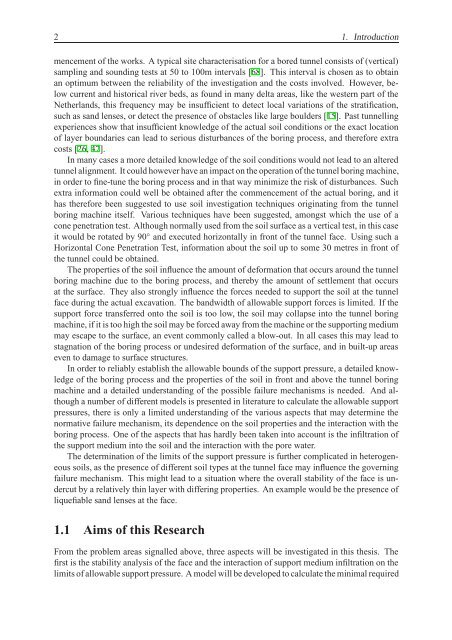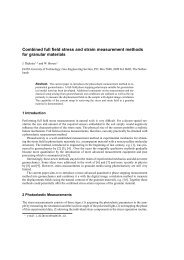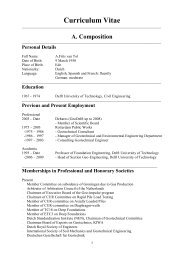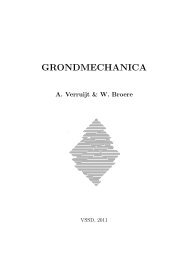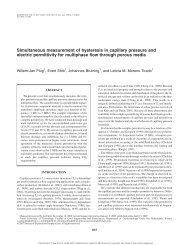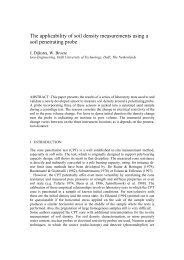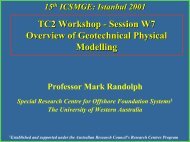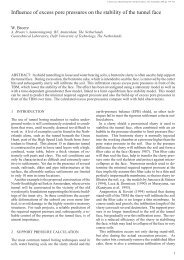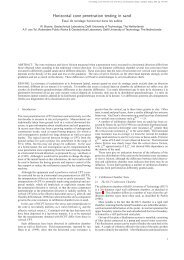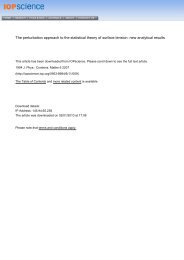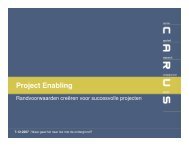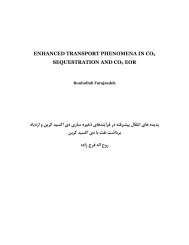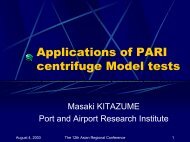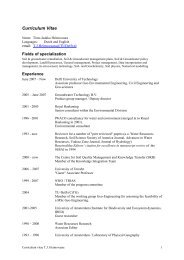Tunnel Face Stability & New CPT Applications - Geo-Engineering
Tunnel Face Stability & New CPT Applications - Geo-Engineering
Tunnel Face Stability & New CPT Applications - Geo-Engineering
You also want an ePaper? Increase the reach of your titles
YUMPU automatically turns print PDFs into web optimized ePapers that Google loves.
2 1. Introductionmencement of the works. A typical site characterisation for a bored tunnel consists of (vertical)sampling and sounding tests at 50 to 100m intervals [68]. This interval is chosen as to obtainan optimum between the reliability of the investigation and the costs involved. However, belowcurrent and historical river beds, as found in many delta areas, like the western part of theNetherlands, this frequency may be insufficient to detect local variations of the stratification,such as sand lenses, or detect the presence of obstacles like large boulders [15]. Past tunnellingexperiences show that insufficient knowledge of the actual soil conditions or the exact locationof layer boundaries can lead to serious disturbances of the boring process, and therefore extracosts [26, 47].In many cases a more detailed knowledge of the soil conditions would not lead to an alteredtunnel alignment. It could however have an impact on the operation of the tunnel boring machine,in order to fine-tune the boring process and in that way minimize the risk of disturbances. Suchextra information could well be obtained after the commencement of the actual boring, and ithas therefore been suggested to use soil investigation techniques originating from the tunnelboring machine itself. Various techniques have been suggested, amongst which the use of acone penetration test. Although normally used from the soil surface as a vertical test, in this caseit would be rotated by 90 ◦ and executed horizontally in front of the tunnel face. Using such aHorizontal Cone Penetration Test, information about the soil up to some 30 metres in front ofthe tunnel could be obtained.The properties of the soil influence the amount of deformation that occurs around the tunnelboring machine due to the boring process, and thereby the amount of settlement that occursat the surface. They also strongly influence the forces needed to support the soil at the tunnelface during the actual excavation. The bandwidth of allowable support forces is limited. If thesupport force transferred onto the soil is too low, the soil may collapse into the tunnel boringmachine, if it is too high the soil may be forced away from the machine or the supporting mediummay escape to the surface, an event commonly called a blow-out. In all cases this may lead tostagnation of the boring process or undesired deformation of the surface, and in built-up areaseven to damage to surface structures.In order to reliably establish the allowable bounds of the support pressure, a detailed knowledgeof the boring process and the properties of the soil in front and above the tunnel boringmachine and a detailed understanding of the possible failure mechanisms is needed. And althougha number of different models is presented in literature to calculate the allowable supportpressures, there is only a limited understanding of the various aspects that may determine thenormative failure mechanism, its dependence on the soil properties and the interaction with theboring process. One of the aspects that has hardly been taken into account is the infiltration ofthe support medium into the soil and the interaction with the pore water.The determination of the limits of the support pressure is further complicated in heterogeneoussoils, as the presence of different soil types at the tunnel face may influence the governingfailure mechanism. This might lead to a situation where the overall stability of the face is undercutby a relatively thin layer with differing properties. An example would be the presence ofliquefiable sand lenses at the face.1.1 Aims of this ResearchFrom the problem areas signalled above, three aspects will be investigated in this thesis. Thefirst is the stability analysis of the face and the interaction of support medium infiltration on thelimits of allowable support pressure. A model will be developed to calculate the minimal required


